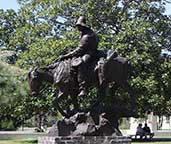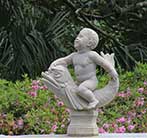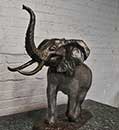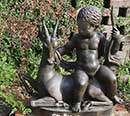Discover Brookgreen Gardens, 2023
American Sculpture - Botanical Gardens - Award Winning
Sculpture and Wildlife reserve
Over 100 photos. I believe this is the largest on-line directory with hundreds of photos
Voted the "top 10" Gardens in the USA
Note: This page may be slow to load, depending on your computer.
and your Internet provider
©Patricia Blackstock
Other Brookgreen events and happenings, click each photo to enlarge.
Page 2. Flowers, plants, trees
Page 3, LowCountry Zoo, Birds, Butterflies
Page 4. Special Events - Nights of a Thousand Candles
Harvest Day and more
* My Brookgreen Photos are FOR SALE!
Here's Brookgreen Gardens official website:
www.brookgreen.org
I designed this page to connect the sculptures at Brookgreen Gardens with photos of the sculpture, the name, sculpture information, dates and a photo. This project has been challenging and exciting. As far as I know, it is the only web page that includes. listings of over 200 sculptures at Brookgreen Gardens, the sculpture, the sculptor, plus more information - and a photo, all on one page. I am the photographer of all the photos you see here. See more information at the bottom of this page.
I am always adding more sculptures. If you are looking for a specific sculpture that you do not see here, please send me the name, location (or whatever you can remember about it.) Or perhaps you have a Brookgreen story to tell. Contact me, Patricia Blackstock. I would love to hear from you.
Brookgreen Sculpture Gardens includes more than 9,000 acres, plus a Wildlife Preserve. Brookgreen has earned accreditation from the American Assoc. of Museums and the Association of Zoos and Aquariums, as well as being designated as an historic site and being listed in the National Register of Historic Places. There are currently over 500 sculptures in Brookgreen Gardens
You are viewing Page 1: A listing of American sculpture, including the name of the sculptor, date and a photo
Page 2. Flowers, Plants, Trees
Page 3. Lowcountry Zoo, Birds, Butterflies, zoo animals, more
Page 4. Special Events, Nights of a Thousand Candles, Harvest Home and more.
We have been living in Myrtle Beach since 1997, and year after year we enjoy our Family Pass to Brookgreen Gardens.
Be sure to check the Brookgreen official website for more information
Join me on Facebook
Visit my website, FunBeaches.com
My Brookgreen photos are for sale :
please copy/paste: http://funbeaches.com/Brookgreen-photos-for-sale/
To learn more about Brookgreen, please visit their official website
CLICK EACH PHOTO to enlarge
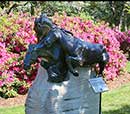

1. Map of Brookgreen. Event Map. Click to enlarge Brookgreen Gardens for Map and Events map 3. and 4. Entrance to Brookgreen: Fighting Stallions by Anna Hyatt Huntington 1950, Aluminum. 5. Fountain of the Muses by Carl Milles in Bronze. The four males on the side of the pool represent branches of the fine arts. In the words of the sculptor, "Each artist carries his symbol with him. The Poet, the Bluebird, The Architect his new formed column; the Musician; his old interesting instrument; the Painter (here represented by Eugene Delacroix) his flowers" 6. Mares of Diomedes - John Gutson de la Mothe Borglum (1867 - 1941) The idea of portraying a group of horses in forward movement was inspired by the sculptor showing the early years of the American West. This is a small selection which included several horses and a rider in the lead. Click eeach photo to enlarge


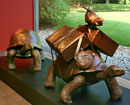



1. (On loan) Field of Blue. Courtesy of the sculptor, George Lundeen (B. 1948) Bronze. Lundeen received a MFA degree from the University of Illinois . A Fulbright-Hayes scholar, he achieved the status of Full Academician of the National Sculpture Society. 2. and 3. The Turtle Train - Bronze by W. Stanley Proctor b. 1939. Gift of Colin S. Phials in honor of Deidre Phipps. Native of FL, W. Stanley Proctor has become adapt at depicting people and their unique traits, characteristics, and personalities. The state of Florida awarded his contributions to the arts when he was inducted into the Florida Artists' ' Hall of Fame in 2006. (Located in the Children's Garden) 4. Pomona by Joseph Emile Renier (1887-1966) Tennessee marble, 1929. After studying at the Art Students League, Joseph Renier worked in the studios of A.A. Weinman and Attilio Piccirilli. He was also awarded the Prix de Rome to study at the American Academy. This sculpture was designed in 1929 and latrer carved in marble. 5. Raphell by Bruno Lucchesi (b. 1926) Bronze. The sculpture fountain was desogned after the untimely death of a young volunteer for a psychiatric hospital in Queens, NY. Here she is, receiving the cool spring water and providing solace to the hospital patients. Commissioned by her parents. 6. Phryne Before the Judges - by Albert Walter Wein (1915 - 1991) Limestone, 1948. Massive in size, this landscape sculpture is an example of the sculptor's early work, which emphasized volume and simplification of detail. Kn the myth of Phryne, the Greek courtesan of legendary beauty secured an acquittal from her judges by revealing her body. Wein studied at the American Academy n Rome. It was subsequently enlarged for Brookgreen Gardens. 7 Seated Woman, Leonda Froelich Fink (1922 - 2017) Bronze, 1998 gift from Mrs. Edward M. Rosenthal. Amng the droup of American artists emerging after World War II, Leonda Froelich Finke is known for serenely expressive images of women. C;ock each photo to enlarge.

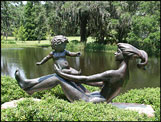
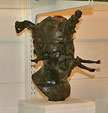



1.
1. Derek Wernher's realistic old man, sitting on a park bench reading a newspaper. The title of the sculpture is the pen name of the newspaper's editor, Len Ganeway. Bronze 1980. 2. Joy of Motherhood - Willard Newman Hirsh (1905-1982) Bronze - Gift of Mrs. Willard Hirsch. Infusing many of Hirsch's works in the spirit od the love of life. The physical and spiritual bone between mother and child was a favorite theme. A native of Charleston, SC, Hirsch not only promoted sculpture through his own work, but also as an instructor, provided opportunities for children and young adults learn the creative process. 3 The Guardian, Sahl Swarz (1912 - 2004) Bronze, 1937. Sahl Swarz was one of Dorothea Denslow's students at the Clay Club in the city of New York. He later became associate director and was part of the evolution into the Sculpture Center. His sculptures were commissioned for government art projects in post offices, courthouoses throughout the1930s, 4. (Currently on loan to the Myrtle Beach Airport (MYR) United We Stand (Flag raising on Iwo Jima) Felix de Weldon (1907-2003) Bronze, 2001, a 13 inch study. Courtesy of the sculptor's estate. In response to the events of 9/11/2001, Felix de Weldon authorized a special edition of this sculpture, the flag on Iwo Jima, often referred to as the Marine Corp War Memorial. In Weldon's words: "This sculptire stands as the American symbol of unity of action,the will to sacrifice, and America's relentless determination to defend freedom." 5. and 6. In his will, Richard McDermott Miller 1922- 2004, left his entire collection to Brookgreen Gardens. The collection is housed in the Offner Sculpture Center, along weith work of other sculptors. Their heads are Miller's selfies.
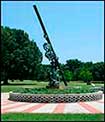


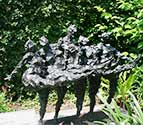
1. 2. Time and the Fates of Man 3. Details from Time and Fof Man Bronze, 1939 by Paul Howard Manship. Symbolic passing of time, the sundial represents the three fates: Clotho, Lachesis, and Atropo 4. and 5. 139th Psalm "If I take the wings of the morning and dwell in the uttermost parts if the sea; even then shall your left hand lead me and thy right hand hold me" 6. Annie's Garden Click each photo to enlarge.
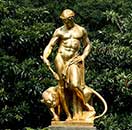
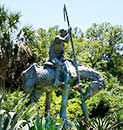
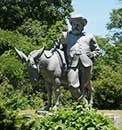
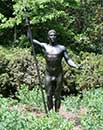
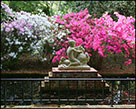
1. Little Lady of the Sea by Earnest Bruce Haswell 1889-1956. After attending Cincinnati (Ohio) Art Academy, he studied in Brussels at the Academie Royale des Beaux-Arts. As World War 1 began, he came home nd created war memorials for many Ohio towns. Later he specialized in fountains, sundials and bird baths. Little Lady of the Sea was acquired by Brookgreen in 1932. 2 The Saint James Triad sculpture is the subject of the book "Voices in Bronze." Richard McDermott Miller 1996-1997. 3. Dionysus Gilt Bronze, 1936 by Edward Francis McCartan. The life-size figure displays McCartan's elegant user of line, giving balance and harmony to the overall commission. 4 Don Quixote - Aluminium 1947 by Anna Hyatt Huntington. 5 Sancho Panza, Aluminium, 1971 by Carl Jennowein, commissioned by Huntington as Don Quixote's companion. 6. The Athlete (1915) by Rudolf Evens, 1887-1960 represents the harmonious beauty of fine physique. The model was a javelin thrower and champion middleweight wrestler. Also known for his "Thomas Jefferson" located inside the Jefferson Memorial in Washington, DC.
Click each photo to enlarge


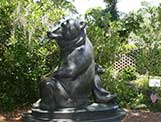
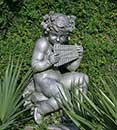
1. Tortoise Fountain, Janet Scudder (1873 - 1940) Scudder was among the first group of American artists to specialize in figures for garden settings. According to the artist, her aim was to please and smuse the world with her sculpture. Lead garden figures were part of a series of castings known as the "Childhood of the Gods" designed by Wheeler Williams in 2940 and made available to the public in 1942 through such patrons as Anna Hyatt Huntington 2. The lead garden sculpture series is an art of castings known as "The Childhood of the Gods" designed by Wheeler Williams in 1940 and made available to the public in 1942 through such patrons as Anna Hyatt Huntington. Flute Boy 3. Mother and baby bear 4. Wood Nymphs, Henry Hering (1874-1949) Aluminum, 1932. Hering worked for sculptor Philip Martiny, then studies with Augustus Saint-Gaudens, eventually becoming his assistant. (1.- 4.located in the Children's Garden.) 5. Pastoral by Edmond Romulus Amateis (1897-1891) Tennessee Marble, 1924. Amateis wassrawn to the workjk of the Italian Renaissance. His intent for good composition and skill resulted in important sculpture commissions. Originally named Mirafiore, this sulpture was modeled in Rome where Amateis was a student at the American Academy. 6. Penguins by Alfred Laessle (1877 - 1954) Bronze, 1917. S.1936.047 Click each photo to enlarge


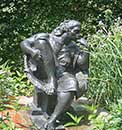
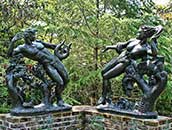
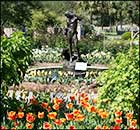
1. Young America by Joseph Walter. This figure was done in the 1940s and was exhibited in a show at the The Metropolitan Museum of New York. 2. Wind on Water by Richard McDermott Miller (1922-2004) Bronze, 1992. Gift of the sculptor. Known as one of the great American sculptures of the human figure in the post World II era, Miller explored the possibilities of composition and innovative design. Miller's award-winning work is in many important public and private collections. 3. Grandmother, from a series by Richard Blake, created to celebrate the beauty inherent in the women of Africa, South America, Mexico and Central America 4. The Offering, by Marjorie Daingerfield (1900 - 1977). Bronze, 1973. The daughter of a painter Elliott Dangerfield, owner of the Gainsborough Studios, Marjorie Daingerfield grew up in the New York art world. She was known for her potraits of individuals and notables from the stage and opera. The Offering was reated for the gardnen of a church in Blowing Rock, N.C. where the family had a summer home. 5. Orpheus and Eurydice by Nathaniel Choate (1899 - 1965) Bronze, 1962, The myth of Orpheus and Eurydice is a tragedy. After Eurydice's untimely death, Orpheus went to the Underworld to persuade Pluto to return him to her. Pluto granted the request, but warned Orpheus not to look back at her until they were in the world above - a warning he did not heed. The sculptor has captured the moment the lovers parted forever. 6. Fauns at At Play, by Charles Keck There are two casts of this sculpture; the original was commissioned to the estate of J. J. Raskob in Centreville, M.D. This copy was exhibited 1921 at the Architectural Leaguein, New York, 1932. Click each photo to enlarge

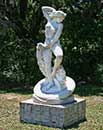
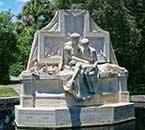


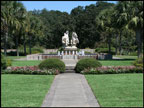
1. Nature Dance - Alexander Stirling Calder - Placed in Brookgreen in 1941, limestone. In a ringed sphere, a woman is poised on one foot, the other knee bent and the body turned in the movements of a dance. A choir of birds rise from beneath her feet to her lowered hand. 2. The Visionaries. Anna Hyatt Huntington and her husband are surrounded by objects of personal interest. By Anna Hyatt Huntington 3 Nymph and Fawn won the competition for the Darlington Memorial Fountain in the Court House Square, Washington, D.C. It was acquired by Brookgreen Gardens in 1940. By Carl Jennewein in Bronze, created 1922. 4. Meditation by Ernest by Wise Keyser (1876 - 1959) Keyser studied with Saint-Gaudens at the Arts Student League and in Paris at the Academie Julian. This contemplative figure was first created for a fountain at a residence in Longbranch, New Jersey. 5. Riders of the Dawn by Adolph Alexander Weinman (1870 - 1952) Indiana Limestone, 1940-1942. Excelling as an architectural sculptor, Weinman crfeated some of his finest work for public buildings. Riders of the Dawn presents the joyous spirit of a new day, youthful vigor embodied by two powerful stallions ridden by young men. The strong muscles of the horses and riders create intricate patters of light and shade as the sun crosses the sky 6. Voratio by Jane B Armstrong (1921 - 2012) Vermontt Verde antique marble, 1969. Gift of the sculptor. After cpmpleting years of teaching and journalism, Armstrong began to study sculpture, and within three years she began winning awards.. Her subjects were primarily from nature, capturing in stone rhythms of living creatures. Armstrong depicted this sphinx caterpillar in a rounded chunky form and gave the stone a high polish. Click each photo to enlarge



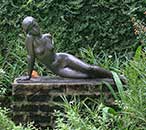
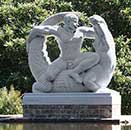

1. The Afternoon of the Faun. Percy Bryant Baker (1881 - 1970) Tennessee marble, 1934. Inspired by the Nijinsky ballet of the same name, this worl is designed in a small size to be cast in bronze. Anna Huntington asked Baker to enlarge the composition and carve it in stone At first he resisted, but once he complied, he demonstrated the delicacy of modeling reserved usually for bronze casting could be recreated in stone. 2.The Thinker, by Henry Clews, Jr. 1876-1937. Aluminum figure on a bronze base, 1914. Clew's satirical artistic commentary delt with the aspects of society, education, government, military, family, love and art. His fascination with evil and its reflections were not well received by the public or critics. The base panel of a blowfish attacked by a group of needlefish shows the perennial struggle between the artist, puffed up with creative works, and the public's criticism of his work. 3 Shark Diver by Frank Eliscu (1912 - 1996) Bronze 1952. Frank Eliscu's experimental methods and materials allowed him to create figures that appear to be floating in space. Shark Diver with its inverted design and many-tentacle sea plant is a foog example of his unusual presentation. 4. Awakening ny Anthony Antonios (b. 1942) Bronze, 1986. Gift of Slone Teague and Family. Anthony Antonios studied art at the Art Students Leahue, Pratt Institute and the National Academy of Design where he now teaches. He has won many awards, including the Gold Medal of the American Artists Society. 5. Bender by Nathaniel Choate, b. 1899. Italian . A man seated on the back of an alligator, his legs gathered under him. With his left hand he grasps the jaw, and his right arm curves around the tail, bending the creature's body in a circle. His powerful muscles are contracted, and the radiating lines of the arms and legs are contrainted with the curving frame of the alligator. Originally carved in mahogany in New York. the sculptor became heavier and the man more robust. He carved it in marble in 1937. Located at the Reflecting Pool. 6. Into the Unknown. Hermon Atkins MacNeil. (1866 - 1947) White marble, 1912. S,1948.001. (Near Brown Sculpture Ctr.) 4. Fountain of the Muses by Carl Milles in Bronze. The four males on the side of the pool represent braches of the find arts. In the words of the sculptor, "Each artist carries his symbol with him. The Poet - the blue bird; the Architect - his new formed column; the Musician with his olf interesting; the Painter (here represented by Eugene Delacroix) - his flowers" 7. Eros and Stag by Gaetano Cecere (1894 - 1885) Bronze 1930. Cecere's sense of design comes to the front in this Garden of America Award in 1930. He was also a teacher, having served as the Director of Sculpture Dept. at Beaux-Arts Institute of Design, Professor of art at American University at St. Louis and Mary Washington in Fredricksburg, VA
Click each photo to enlarge
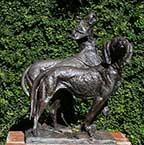

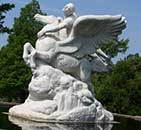

1. American Foxhounds by Walter T. Matin (b. 1953) Bronze, 1997. By tradition, foxhounds are counted in couples, and they are hounds, not dogs. This pair of female hounds was modeled from the winners of an annula Virginia foix hunt show. 2 Man Carving his own Destiny Albin Polasek 1879 - 1965. The sculpture of Indiana Limestone was created when Polasek was a student at the PA Academy of Fine Arts. 3. Pegasus, Augustus Saint-Gaudens (1848-1907) 4 and 5. Diana. The bronze Diana in the collection of Brookgreen Gardens was made from a unique Portland cement cast of the second version which Saint-Gaudens had given in 1894to his friend and frequent collaborator, Standord White, the architect of Madison Square Garden. 6. Two Kids by Oronzio Maldarelli (c. 1892 - 1963) A pattern of diagonals make this group appealing. The balance of form and ornamental treatment of details which enhance the quality. Maldarelli's garden sculptures often feature stylized decoration. Click each photo to enlarge


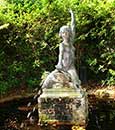



1. Call of the Sea. Bronze. By Harriet Frishmuth. Frishmuth made name for herself through youth sculpture by producing a series of lithe female forms. Call of the Sea was posed by a dance student and is an example of Frishmuth's exuberant style. Brown Sculpture Court, located in the center of the sculpture gardens, it contains a permanent exhibition of smaller works and many white marble pieces. This display surrounds an elegant reflecting pool and a cascading water feature. 2. Reaching, EvAngelos William Frudakis. Bronze, 1006. Lovely Waterfall - Hydrangea and pathway. 3. Sunflowers by Charles Cooper Parks ( 1922 - 2012) Bronze 1974. Charles Park created a series of children and young women placed in whimsical or improbable positions to depict the fantasy and charm of youth. Sunflowers was donated to Brookgreen in 1984 4. Nature's Danceby Alexander Stering Calder (1870 - 1945) Limestone, 1938. Through garden sculpture, Alexander Stirling Calder was able to show his innovative and decorative flair. Symbolic of Mother Nature, dancing in joyful abandon and standing on a ringed sphere, the figure is encircled by a curving array of birds 5. Young Diana by Anna Hyatt Huntington in Bronze - 1924 6. Diana of the Chase by Anna Hyatt Huntington Figure of female mythology with dog The goddess stands on a globe, gazing upward, the bow raised in her left hand, the right hand drawn back after releasing the string. Her hair is in short curls. A piece of drapery falls from her right hand. A hound leaps upward at her feet. Click each photo to enlarge.
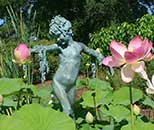

1. Seaweed Fountain by Beatrice Fenton (1887 - 1983) Bronze, 1920. Although Fenton's most important works were lively fountains of realistic figures embellished with fanciful ornaments, she also won awards for animal and portrait sculpture. Seaweed Fountain received the Widner Gold Medal of the APA Academy of the Fine Arts in 1933. 2. Marabou by Eugenie Frederica Shonnard, (1886-1978) Napoleon Gray Marble, c.1915. After studies with Alphonse Muca and James Earle Fraser in New York, Shonnard went to Paris in 1911and received criticism from Bourdelle and Rodin. The elongated lines of wading birds suited her as subjects and she ccreated many for private gardens,. 3. Narcissus by Adolph Alexander Weinman (1870 - 1952) Tennessee Marble. Illustrating the myrh of Narcissus, the youth who fell in love with his own reflection. This award-winning work presents pleasing line and decrative modeling. Weinman's body of worlk extended from such charming garden figures to architectural sculpture, monuments and medallic art. 4. Sundial by Brenda Putnam (1850 - 1975) Bronze on Georgia pinkmarble pedestal, 1931. As a young sculptor, Putnam created a series of fountains and sundials that helped establish her career. Sundial continues the theme adapted from Renaissance sculpture, featuring many children and animals. Putnam's cheerful cherubs never fail to please and amuse. 5. Griffin, by Paul Howard Manship (1885-1966) Limestone, 1917. This mythological creature and its companion was part of a large sculpture that Manship created for steel ndustrialist Charles Schwab at Loretto, PA. In antiquity, the Griffon, with the body of a lion, the wings and head of an eagle, was a powerful and majestic symbol of divine power Click each photo to enlarge.
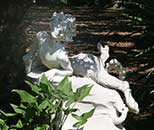




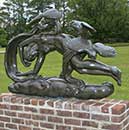
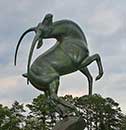

1. Persephone by Marshall Maynard Fredricks (1908-1998) Bronze. Persephone, Greek Goddess of spring and queen of the underworld, was allowed to spend 6 months of the year in Hades with her husband, Pluto, and 6 months above ground with her mother, Demeter, Goddess of the HarvestFredricks depicted at the oment of her ascension from the world of the dead to the relm of the living, just as a plant sprouts below ground emerges through the soil. 2. Evening by Paul Howard Manship (1885 - 1966) Bronze, 1938 - Evening is the study sculpture for one of our sculptures known as "The Moods of Time" that Paul Manship created for the 1939 New York's World Dair. Manship repeated the use of figures in a floating, horizontal design in many of his successful works. 3. Gazelle Fountain by Marshall Maynard Fredericks (1908-1998) Bronze. The sleek gazelle was adapted from the central figure of the Levi Barbour Memorial Fountain on Belle Isle near the Detroit River. In 1936 this design won first place in a national competition. In 1972 it won the purchase prize in sponsored by Brookgreen Gardens. 4 Cares for her Brothers by Veryl Goodnight (born 1947) Bronze, 1985, gift of Mr. and Mrs. Wynant J. Williams. Colorado native Goodnight began her career as a painter but radial Cares for her Brothers" was the first of a series that explored the interrelationships of humans and animals. The pioneer woman gently holding a deer fawn depicts the Cheyenne story of Ewo-Wumishi-He-Me, the woman who cared abour all living creatures. 5. Tickled by Louise Peterson Sculptor. On loan to Brookgreen. National Sculpture Society Brookgreen 2011 Awards. 6. Laughing Boy and Goat byAttilio Piccirilli (1866 - 1945) Lead 1946. The eldest of 6 brothers, Piccirilliheaded the family stone carving studio. He was the sculptor of several important works including the Maine Monument and figures on the facade of the Brooklin Museum. This little sculpture was designed in 1936 on a creative impulse of the sculptor. 7. Pledge of Allegiance, by who Glenna Goodacre is best knownfor having designed the Sacagawea dollar that entered circulation in the United States in 2000. She also designed the Women's Memorial located in Washington D.C. Click eeach photo to enlarge




1. Disarmament by Daniel Chester French (1850-1931) Bronze, 1919. Known as the sculptor of "Seated Lincoln" in the Lincoln Memorial and "The Minuteman" in Concord, Massachusetts, French produced some of America's best loved monuments. "Disarmament" was modeled for a temporary Victory Arch in NY City at the close of World War 1. The rugged warrior, with his massive sword and battle-worn appearance, smiles gently at an infant, who reaches up to him. 2. Boy and Frog, Elsie Ward Hering (1872-1923) Bronze. As an assistant in the studio of Augustus Saint-Gaudens, Elsie Hering helped finish much of the sculptures done toward the end of his life. After his death in 1907, she completed a commission that was praised as an "astonishingly beautiful and poetic result filled with th spirit of his life." This example of her own delightful sculpture was awarded a bronze medal at the St. Louis Exposition in 1904. 3. Creation: She is the East where dawn brings the new day. She is spring when the land bursts into bloom. She is water, the cradle of life.. From Circle of Life by Harold "Tuck" Langland (born 1939) Bronze, 2001. Gift of Tuck and Janice Langland. Using the metaphor of dance, this group of 4 figures (two shown above) represents the cycles of human life, four seasons, four elements, and four directions. Each figure has an accompanying poem written by the sculptor. 4. Bring: He is the south with the sun high in the day. He is summer with growth abundant. He is air and brath of life. From Circle of Life by Harold "Tuck" Langland (born 1939) Bronze, 2001. Gift of Tuck and Janice Langland. Using the metaphor of dance, this group of 4 figures represents the forms of human life, four seasons, four elelments, and four directions. 5. Transformation: He is the West where the descends blazing. He is autumn when living things look to their rest. He is transforming fire. From Circle of Life by Harold "Tuck" Langland (born 1939) Bronze, 2001. gift from Tuck and Janice Langland. Using the metaphor of dance, this group of 4 figures (two shown above) represents the cycles of human life, four seasons, 4 elements and 4 diretions. Each figure has an accompanying poem written by the sculptor. 6. Dormancy: She is north who waits in darkness. She is winter when all is still. She is earth listening for spring rain. From Circle of Life by Harold "Tuck" Langland (born 1939) Bronze, 2001. Gift of Tuck and Janice Langland. Using the metaphor of dance, this group of 4 figures (two shown above) represents the cycles of human life, four seasons, four elements, and four directions. Each figure features a poem written by the sculptor 7. Jaguar by Anna Hyatt Huntington (1876 - 1973) Bronze, 1907. Among Huntington's early sculptue success was a series of jaguar studies done at the New York Zoological Society. The model, "Senor Lopez" was a beautiful creature, legendary for his size and ferocity. Huntington worked from memory of a split second when the animal began to move from an upper level down to his food bowl. Click each photo to eenlarge
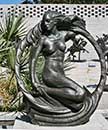

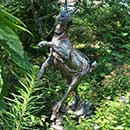
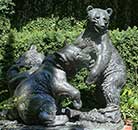
1. Nebula by Avard Tennyson Fairbanks (1897 - 1987) Bronze, 1934. Gift of Dr. Grant Fairbanks 2. Dancing Goat by Albert Laessle (1877-1954), Bronze, 1928. A goat on its hind legs iss standing in a clump of rushes containing a snail, turtle and other marsh creatures, The hair risesin a ridge and the collar encircles its neck. 3. Brown Bears by Anna Hyatt Huntington (1876 - 1973), Bronze, 1035. Gift of sculptor. A group of three bears are playing. One stands on his hind legs, , sparring with another, A third, leaning against a log is licking a hind foot. Huntington's sculpture which started when she was 13, continued until her death at 97. In 1985 she was in ducted into the SC Hall of Fame. 4. Heron, Grouse and Loon, by Elliot Offner (b. 1031) Bronze, 1992, Gift of family - Austin P. Kelley. Offner is known for his sculpture's meticulous surface treatments and compositions. The first casting of Heron, Grouse and Loon was created in 1992 for a downtown n location in Minneapolis. 5. In Memory of the Work Horse, by Anna Hyatt Huntington (1876-1973) Bronze, 1964. During her youth, Anna often observed and worked with large group of horses bred for plowing and hauling hay at the family farm in Annisquam, Massachusetts. 6. The Plantation Owner: Plantations were designed to grow things on a large scale for exportation. In coastal Carolina, the plantation owners were known as Planters. Babette Bloch experimented with various sculpture media, and discovered laser-cut technology. Four stainless steel figures were commissioned in 2004 and 2006. Click each photo to enlarge
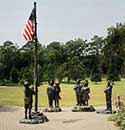
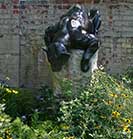

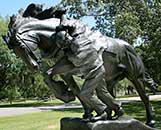


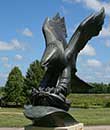

1. Awakening by Vincent Glinsky (1895-1975) Tennessee marble, 1946. Vincent Glinsky was a proponent of direct-carving, where the sculptor carvved directly into stone, using no preliminary model. Thi sculpture depicts a woman rousing from deep slumber, her body heavy and and languid with sleep. Glinsky emphisized this work by leaving the marble block uncarved beneath the figure. 2. Diving Eagle by Albino Manca (1876-1973) Bronze, 1963. Diving Eagle is the half-size model of the United States monument to those who died in the Atlntic Ocean in World War II. The large monument is located in New York City's Battery Park, near the former site of the Workk Trqade Center. The eagle symbolically places a werath upon the crest of a wave. Since its completion, this sculpture has won many awards. 3. Wildlife Column by Anna Hyatt Huntington (1876-1973) Bronze, 1963. An expert animal sculptor, Anna embellished this work with wildlife native to the Southeast. Anchoring each corner are a fox, beaver, goose and duck. A spiral of heron-like birds rise from the top. 4. Presidential Eagle, Sandy Scott, (b. 1943) Bronze, 2004. On loan from the sculptor. The eagle isa favorite subject for Sandy Scott. In 2004 this sculpture was enlarged from a small composition. This is the first casting of Presidential Eagle. 5. Lions by Anna Hyatt Huntington (1876-1973) Bronze, 1930. The two handsome lions were first placed in1930 at the the entrance of thr Society of America in New York city, a museum founded by Archer Huntington. The bronze versions in NY were replaced bt duplicates, carved in limestone and the bronze versions were brought to Brookgreen Gardens. Each lion protects their own part of the world as revealed on the globes between the lions' paws. 6. Child of Peace by Edward Fenno Hoffman III (1916-1991) Bronze,, 1962. Gift of the family. Anne Morrison Chapman. A love for small children and other creatures often inspired Hoffman's depictionof a young boy with a dove resting against his chest. The tender portrayal of childhoodshows Hoffman's philosophy: "I want to animate my sculpture with an inner life that people sense when observing it. "This sculpture received the Dr. Maurice B. Hexter prize. Click ant photo to enlarge





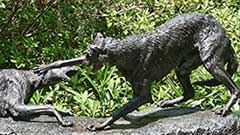
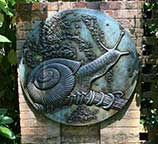


1. Ecstasy by Gleb Derujinsky (1888-1975) The sculptor composed this group with the emphasis on space surrounded by figures. The wave-like movement creates a work of dynamic energy. Ecstasy was designed for Brookgreen Gardens 2. Deerhounds Playing by Anna Hyatt Huntington (1876 - 1973) Bronze, 1949. Two Scottish deerhounds face one another in a mock battle. This lively composition is enhanced by the attitude of playfulness. 3. The Sixth Day by Chester Martin (b. 1934) Bronze, 1980. Noted as a painter, Chester Martin worked for the U.S. Mint as an engraver. He experimented in relief sculpture. In 1980 he entered the Society of Medalists' National competition to design the 50th anniversary commemorative medal. The Sixth Day won 1st Place. It was enlarged and presented it to Broookgreeen Gardens in 1982. 4. Nereid by Berthold Nebel (1889-1964) Gris de Alicia marble, 1945. As a young man, Berthold Nebel designed terracotta ornaments for a NJ firm. He later studied with James Earle Fraser at the Art Students League. In 1914 he won the Prix de Rome Fellowship at the Academy. 5. Inspiration by Edward Field Sanford, Jr. (1886-1951) Bronze, 1028. Click any photo to enlarge
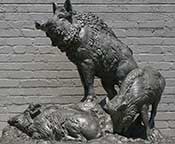
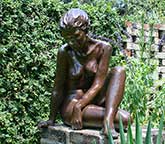
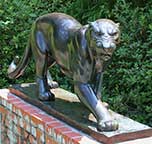
1. Wild Boars by Anna Hyatt Huntington (1876 - 1973) Aluminum, 1935 2. Isabel by Betty Branch (b. 1945) Bronze, 1983. Beginning as a painter, Betty Branch did not take up sculpture until the 1970s. Since then, she has traveled a circuitous road of self-study. Her work is comprised of variety of media including stone, metal, cloth, fiber and natural materials. 3. Black Panthers by Wheeler Williams (1897-1972) Oxidized silver-plated bronze, 1933. Although known for featuring human figures, Wheeler Williams was also interested in animal subjects. This panther and its companion were modeled in his studio in Hollywood, CA. The pair were awarded the Ellin P. Speyer Prize at the National Academy of Design in 1940. 4. Rain, by Avard Tennyson Fairbanks 1897-1987. Bronze, 1933 5. The Whip by George Frederick Holschuh (1902 - 1999) Bronze 6. Pas de Trois by John Cavanaugh (1921-1985) Bronze. John Cavanaugh was a pioneer for hammering and forming sculpture designs from sheets of lead. Pas de Trois, depicting three ballerinas with hands joined above their heads were done in 1983. President Bill Clinton presented a small version of this sculpture to President Jacques Chirac of France in 1995. Clickweach photo to enlarge

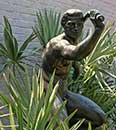

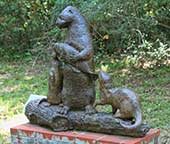
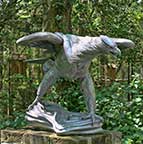
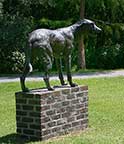
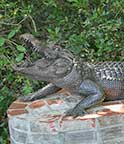
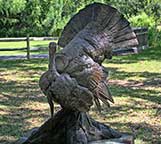
1. First Fish by Carter R. Jones (b. 1943) Bronze, 2007. Carter Jones studied at the Museum of Fine Arts, Boston, and then studied in Paris. After spending time at Brookgreen, he designed the 2004 Brookgreen Medal, which featured the River Otters. The whimsical group of a mother wutg two kits was modeled to appeal especially to children. 2. The Eagle's Egg by Ralph Hamilton Humes (1902-1981) Aluminum, 1953. Humes took up sculpture as physical therapy after the loss of several fingers and an eye in a bobm explosion while in the Army. Recognizing his artistic ability, the government paid for one term of study at the Rinehart School in Baltimore. 3. Wolf and Wolfhound by Zenos Frudakis (b. 1951) Frudakis is a sculptor of the human figure. He has modeled portraits of prominent persons such as Bishop Desmond Tutu and Dr. Martin Luther King. Wolf and Wolfhound, commissioned in 1985 for an estate in Vineland, NJ, is comprised of two separate sculptures. The hound was awarded Silver Medal at the National Sculpture Society exhibition in 1986. 4. Alligator by David Hunter Turner (b. 1961) Gift of the sculptor. The son of a wildlife sculptor William H. Turner, David grew up with sculpture. He studied with his father and became an avid naturalist, earning a degree in biology from the College of William and Mary. 5. A Fool for Love by Walter T. Matia (born 1953.) Bronze 2004. Gift of the Sculptor. Walter Matia knows the symbiotic relationships among works of art, conservation of the environment, public suppofrt of museums, and species preservation. winner of the Nationsl Sculpture Society BronzeMedal in the 72nd Annual Awards Exhibition, A Fool for Love depicts a male wild turkey trying to attract a female. 6. Maidenhood located in the Brown Sculpture Center, by George Barnard, using chorus girl Evelyn Nesbit as the model. Click each photo to enlarge



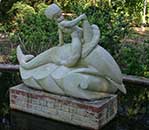
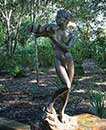
1. Actaeon by Paul Howard Manship (1885 - 1966) Gilt Bronze, begun in 1915, enlarge and completed in 1924. At the American Academy in Rome, Manship derived his inspiration from ancient art. The use of repetitive patterns in hair, fur, and enameled eyes helped place his work in the forefront of American sculpture. Actaeon and his companion Diana (both sculptures are located at the far end of the walk near the Old Rice Plantation) depict the myth of the unfortunate hunter ho surprised Diana as she bathed in a woodland pool. Enraged, Dana turned him into a stag, and he was killed by his own hounds. Diana by Paul Howard Manship (1885 - 1966) Gilt Bronze, begun in 1915, enlarged and completed in 1924. 2. Diana (companion statue to Actaeon) Actaeon depicts the myth of the unfortunate hunter who surprised Diana in a woodland pool. Enraged, Diana turned him into a stag, and he was killed by his own hounds. 3. Triton on Dolphin by Benjamin Franklin Hawkins (1896 - 1898) Limestone, c. 1933 After studying at the St. Louis School of Fine Arts and the Beaux-Arts Institute of Design, Hawkins made architectural sculpture his specialty. The sharp defined[lanes of this group indicate his chosen field. Triton on Dolphin was awarded the Avery Prize from the Architectural League in 1933. The sculpture was carved by Master Carver, Roger Morigi. 4. Lioness and Cub by Hope Yandell (b. 1947) Bronze, 1981 Gift of sculptor in honor of Margaret Mason Peabody. Hope Yandell came to sculpture through a route of self-study and experimentation. The great-niee of sculptor Enid Yandell, she grew up in a family that encouraged artistic expression. In 1980 she enrolled at the National Academy of Design Schoo. The stone base is an integral part of Lioness and Cub, Yandell's first major commission. 5. Shell Boy by Avard Tennyson Fairbanks (1897- 1987) Bronze, 1933 Gift of Grant R. Fairbanks, M.D. Avard Tennyson Fairbanks showed early artistic talent and won a scholarship at age 13 to study at the Art Students League with James Earle Fraser. In addition to creating a number of monuments, portraits and animals, Fairbanks taught sculpture and orgganaized art departments in universities throughout the USA. This work was created when he was a sculptor in residence at the University of Michigan. 6. African Elephant Robert Henry Rockwell, 1885 - 1973
Click each photo to enlarge
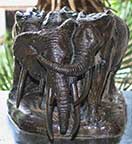
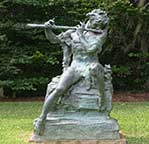

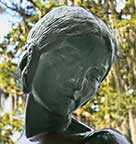
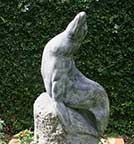
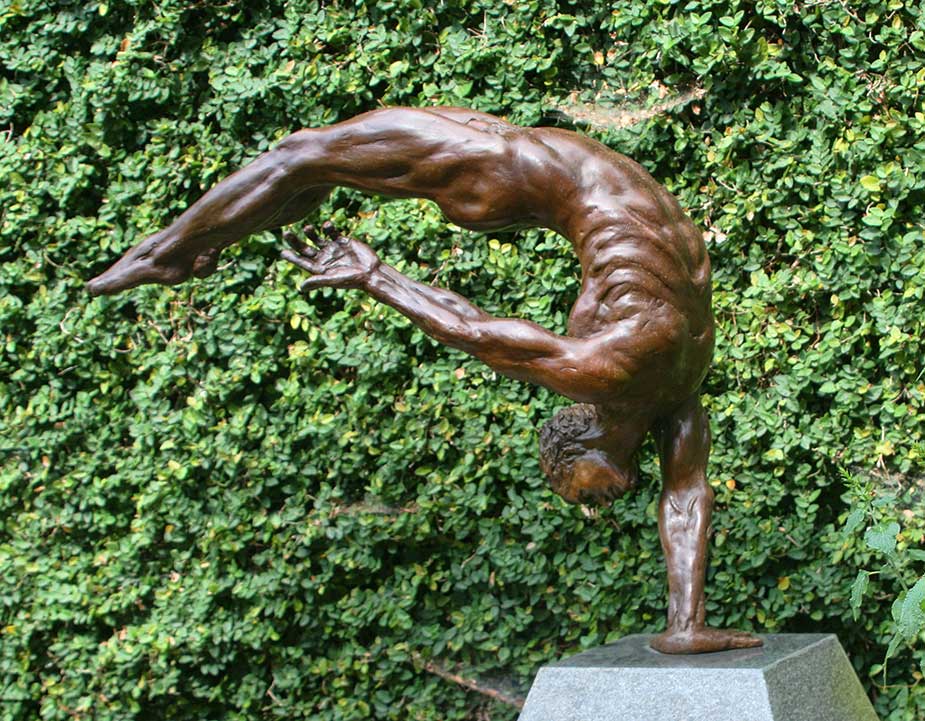
1. The Wounded Comrade by Carl Ethan Akeley (1864 - 1926) Bronze, 1913. A gift of Robert V. Hatcher, Jr. 2. Faun by Leo Lentelli (1879 - 1961) Bronze, 1931. Coming the the United States from Rome as an experienced sculptor in 1903, Lentelli worked in the studios of Philip Martiny, Stirling Calder, and other American sculptors in New York. His impressionistic style, long limbered fingers and flair were especially suited to architectural works and fountain figures. Faun was created for the Boca Raton Club in FL and three examples were cast. This one was acquired by Brookgreen in 1932. 3. and 4. Forest Idyl by Albin Polasek (1879 - 1965) Bronze 1903. A period of study at the American Academy helped develop Polasek's sense of style and affinity for the human figure. After his return toAmerica in 1913, he took a job as head of the sculpture department at the Art Institute in Chicago. In 1930 he returned to the American Academy as a visiting professor where this sculpture was modeled. 5. Seal by Furio Piccirilli (1868 - 1949) Black Marble. One of six beothers who worked in the old world tradition in the family stone carving business, Furio Piccirilli specialized in figure sculpture and was considered the most creative of them all. Seal was awarded the Speyer Prize in the National Academy of Design exhibition in 1929. 6. The Diver by Stephen H. Smith (born 1958) Bronze on granite base, 2007. Stephen Smith earned his MFA in Sculpture from the University of North Carolina. Compositionally, this sculpture illustrates the harmony and grace of the diver as he is about to leave the platform. It was shown in the National Sculpture Society's 75th Annual Awards Exhibition wgere it won the " Peoples Choice Award."

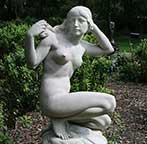

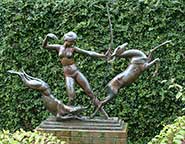
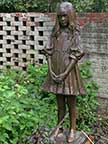

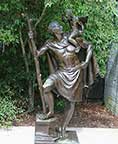



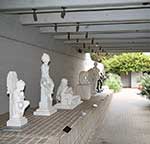
1. Tragedy and Comedy by Alexander Stirling Calder (1870 - 1945) Bronze, c. 1928. One of the first American sculptors to place emphasis on the decorate qualities of his art. His method progressed from the realism of the 19th century toward an increased stylization of forms. The two figures oh Hamlet and Touchstone epitomize 'Tragedy and Comedy' in Calder's prentatation of hhumor and drams with decorative detail. The herioc bronze work is a memorial to William Shakespeare. Brown Sculpture Court. 2. Joy, by Karl Heinrich Gruppe (1893 - 1982) Tennessee Marble, 1925 The son of an American artist who painted scenes of Holland, Karl Gruppe spent his youth near The Hague. After the family returned to New York City, he worked in the studio of Herbert Adams and studied at the Art Students' League. He later became an assistant to Karl Bitter and Charles Cary Rumsey. An early version of Joy was awarded the Barnett Prize of the National Academy of Design in 1926. 3. Fall of France by George Demetrios (1896 - 1974) Gift of heirs of George Demetrios. George Demetrios came to Boston from Greece in 1912. His talent for drawing brought forth financial sponsorship, allowing him to attend the school of the Museum of Fine Arts, then to apprentice in the studio of Charles Grafly. His belief of firect drawing as a basis for sculpture resulted in work of pure line with little detail. Demetrios was profoundly moved by the events of World War II. This sculpture expressively depicted his mood of despair. 4. Kaethe, Age Nine, by Sigmund Abeles (b. 1934) Bronze 1968. As a draftsman, etcher. lithographer, pastellist and sculptor, Sigmund Abeles has received internationa acclaim as one of the country's leading realistic artists of the post-war era. Having spent his childhood in Myrtle Beach, Abeles visited Brookgrden often, and credits the gardens as "the spark that set him afire for realism." Sigmund Abeles' ability to capture an intense solitary human portrait is evident in this pensive sculpture of a young girl. Near Offner building. 5. Builders of the Future, by William Zorach (1887 - 1966) Bronze, 1938. Gift of William N. Bloom, Brown Sculpture Court. 6. Peace Fountain by Sandy Scott (b. 1943) Bronze, 1996. Gift of family and friends of Linda S. Burnett. This presentation of Birds in Flight and its many possibilities has always intrigued Sandy Scott as a sculpture theme. Scott believes her images of aerodynamics (a result of more than 25 years as a licensed pilot) has been helpful in achieving the illusion of movement and motion in her sculpture of birds. Click each photo to enlarge.
1. The Source by Janice Mauro (b. 1953) Bronze, 2011. Janice Mauro's sculpture often presents the female form as a center of spiritual energy. Seen as classical images, the figures are metaphors for beauty, wisdom or power. Water in ancient religion amd myth is depicted in this serene sculpture reminiscent of figures on medieval cathedrals. Though depicted as quiet and reverent, this sculpture also generates physical and emotional power. 2. St. Christopher by Eleanor Mary Mellon (1894 - 1979) Bronze, 1967. Gift of the sculptor. Eleanor Maty Mellon, studied with A. A. Weinman, Harriet Frishmuth, Robert Aitken, and Charles Grafly. The sculptor of garden figures, she was known for religious themes such as Sy. Christopher: "Behold St. Christopher, then shalt thou be safe. "Diana by Gleb W. Derujunsky (1888 - 1975) Bronze, c. 1925. One of Derujunsky's popular small bronzes, Diana creates a delightful pattern with a sweeping rush of bodies. An accomplished pianist, Derujunsky may have been influenced by his talent in woodcarving also enabled him to create a pleasing yet workable compositions. 4. American St. Francis by Charles Cropper Parks (1922 - 2012) Bronze 1969. The idea of a predator and prey coexisting in harmony, represented here by hounds and raccoon, is a recurring theme in the works of Charles Cropper Parks. Originally titled 'Boy and Dogs' this work was created a fountain Plaza, Wilmington, Delaware. The llifetime works of Charles Cropper Parks are a Delaware treasure. 5. Brown Sculpture Court features many marble sculptures
Click each photo to enlarge
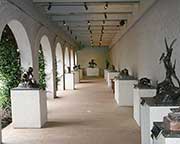
1. Brown Sculpture Court 2. Boy and Panther, by Rudolph Evans 1878 - 1960) Bronze, 1819. This sculpture is an interpretation of Rudyard Kipling's Mowgli from 'The Jungle Book'. Evans was a versatile sculptor of architectural sculpture and public monuments such as the statue of Thomas Jefferson in the Jefferson Memorial Washington, DC 3. The Bat - by Lawrence Tenney Steven (1896 - 1972) Steven began modeling figures while he was still in junior high school in Massachusetts. He was accepted at the Boston Museum School and went on to the Prix de Roma in 1922, to study for three years at the American Academy in Rome. 4. Timber Wolf Family by William Henry Turner (born 1935) Bronze 1990, gift of Dorothy R. Blair. A self-taught artist, Turner experiments with modeling and casting techniques, and has built his own foundry. At a young age, he became interested in taxidermy and sculpture after Robert H. Rockwell, noted animal sculptor and curator of the American Museum of Natural History, retired near Tirner's home and eventually became his mentor. In 1989, Turner was commissioned by the museum to create this work as a memorial to Rockwell. 5. Baboon by Marshall Maynard Fredricks (1908 - 1998) Bronze, 1939. A male baboon sits in a crouching position, his hands on both knees and his teeth bared.
Click eacv image to enlarge

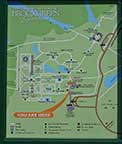
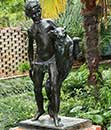



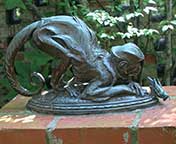
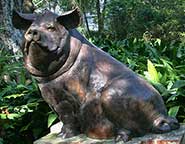
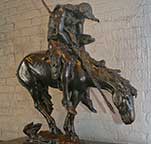
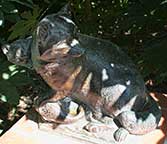
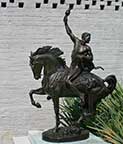

1. Chico by E. Bruce Moore (1905 - 1980) Bruce Moore attended the Pennsylvania Academy of Fine Arts from 1922 to 1926, studying with both Albert Laessle and Charles Grafly. In this sculpture, a monkey crouches on it forelegs, and watches a grasshopper. The sculpture was created in 1927. 2. Eat more Beef by Sandy Scott (born 1943) Bronze. Gift of Trish Smith. A grduate of the Kansas City Art Institute, Sandy Scott started her art career in the 1970's as an award-winning printmaker. Today she is one of the country's leading animal sculptors. 3. The End of the Trail by James Earle (1870 - 1953) Bronze 1950. S.1932.001 4. The Listeners by Hazel Brill Jackson(1894 - 1991) Bronze, 1962. Although Hazel Jackson was born in Philadelphia, her family went to Italy to live when she was a child. She returned to America at the outbreak of World War I, but after WW1 jhe went back to Rome and worked until 1935. The Listeners resulted from observing a racoon family living in her icehouse for several years in Newburgh, New York. 5. The Torchbearer, 1953, by Anna Hyatt Huntington (1876 - 1973) Bronze, 2959, S.1994.003. permanent loan from the Hispanic Society of America Click each phoro to enlarge.
1. Children with Gazelle by Anthony de Francisci (1887 - 1067) Soon after emigration to America on 1902, de Francicsci continued his studies at the National Academy of Design, Cooper Union and the Art Students' League. This sculptures was modeled in New Tork, and carved in 1937. The contrast between the animal's tense muscles and the children's chubby forms create an interesting design. 2. Seated Fawn by Janet Scudder (1873 - 1940) Bronze, 1942. Scudder was among the first group of American artists to specialize in figures foor garden settings/ According to the artist, her aim was to please and amuse the world with her sculpture. The gaiety of her figures was empered by her sense of style, featuring sleek surfaces and emphasis on line. 3. Nymph by Paul Fjelde (1892 - 1984) Bronze, 1932. Fjelde's early skill in creating busts and portrait reliefs enabled him to become an assistant to Lorado Taft in Chicago. He continued studies in Copenhagen and Paris. Fjelde's flair for finely-modeled ornament is evident in this lovely figure 4. Sea Horse by Joseph Kiselewski (1901 - 1988) Bronze 1937. A versatile sculptor, Kiselewski had extensive training. Four years as an assistant to Lee Lawrie allowed him to develop a state of perfection evident in his designs and detail. Sea Horse was one of four castings commissioned for the fountain pools in Radio Corp. of America display in the 2939 New York World Fair. 5. Sea Urchin by Edward Berge (1876 - 1924) and Henry Berge (1908 - 1998) Bronze 1921.Gift from the family of Anne Morrison Chapman. While on visit to the shore, Edward Berge watched young children excitedlyheld up their treasures for all to see. Inspired, he used his niece Sarah as a model to re-create this moment in time. Click each photo to enlarge

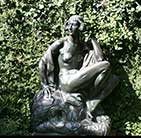
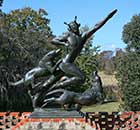

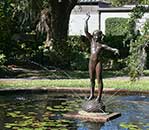
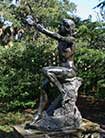
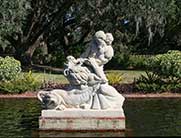
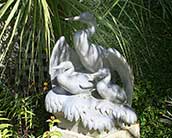
1. Girl With Fish by Harriet Hyatt Mayor (1868 - 1960) Bronze. Remembering stories of Rudyard Kipling's 'The Jungle Book' Harriott Mayor was inspired to create this female versoion of the impish prankster, Mowgli. The sister of Ann Hyatt Huntington, Mayor was the first sculptor in the family. 2. Samson and the Lion by Gleb Derujunsky (1888 - 1975) Limestone 1949. Derujunsky's work included a large number of biblical themes such as this powerful rendition of Samson and the Lion. As proficient at carving as he was at modeling in clay, Derujinsky worked in both stone and wood. 3. Group of Anhingas by Gustave Bohland (1895 - 1959) Aluminum, 1936 A female anhinga, or water turkey, on the nest shelters her fledglings beneath her wings. This group ornamented the facade of Bohland's. A native of Austria, \he was best known for portraits and bas-reliefs. 4. Primitive Man and Serpent by Roland Hinton Perry (1870 - 1941) Bronze, 1899. Originally titled Thor and the Midgard Serpent, this work portrayed the final battle of Ragnorok - the twilight of the gods and the end of the world in Norse mythology. The Thunder God Thor killed the serpent Jormangund, but then he died from exposure to it's deadly venom, the myth representing the end of paganism and the begining of the Christian era in northern Europe. 5. Scratching Doe by Dan Ostermiller (b.1956) Bronze, 1996. Gift of Nedra and Richard Matteucci. A fascination with wildlife led Dan Ostermiller to age to become a sculptor. Although his work is realistic, it is not just an accurate rendering of the subject, but an artistic line of composition. a self-taught artist. Ostermiller draws on his vast amount of knowledge of animal anatomy acquired through many years of keen observation. Click each pghoto to enalage

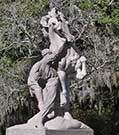
1. Youth Taming the Wild by Anna Hyatt Huntington (1876 - 1973) Limestone. The founders of Brookgreen Gardens, Anna and Arthur Huntington created a haven for various plants, animals and American Sculpture. One of the first pieces to be placed here, Youth's theme was adapted for Archer's father, Collis P. Huntington, one of the "big four" who helped build the transcontinental railroad. The idea of a burgeoning America, represented by a vital young man, taming tthe rearing horse of the wild west. 2. St. Francis by Julian Hoke Harris (1906 - 1987) Bronze, 1962. A native of Georgia, Harris was a relative of the author, Joel Chandler Harris. He studied architecture and had a teaching career at the Georgia Institute of Technology that paralleled his career as a sculptor. Harris's skill in portraiture and bas-relief led to important commissions such as the inaugural medal for President Jimmy Carter. 3. St. Francis ny Bruce Moore (1905 - 1980) Bronze. S.1947.00S. 4. The Youthful Franklin by Robert Tait McKinzie (1867 - 1938) Bronze 1914. TRis sculpture was done for the campus of the University of Pennsylvania. The illustrator, Howard Pyle, made a number of sketches of the costume of a boy from the Colonial period to assist McKenzie in his job. The sculptor used the Houdon bust of Franklin as a model for the face. Trained in medicine, McKenzie was a professor of physical education whose interest in the development of body led to sculpture. 5. Loie Fuller: Vortex, by Barbara Lekberg (born 1925) Bronze 2005, Acquired by the Sculpture Purchase Fund. Known for metal welded figures, Barbara Lekberg learned to weld with Sahl Swarz at the Sculpture Center in New York during the late 1940s. Loie Fuller: Vortez, is inspired by an earlier welded figure represents the fluid movement of a dancer spinning while her skirt swirls around her body. 6. Coming og age, by Paul Moore (born 1957.) Bronze, 1995. Gift of the scuptor. S2007.009 Click each image to enlarge

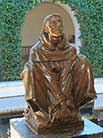
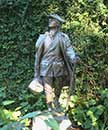

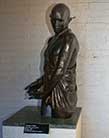
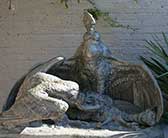

1. Vultures by Anna Hyatt Huntington (1876 - 1973) Aluminum, 1933 S. 1939.003 2. Between Yesterday and Tomorrow by Edith Howland (1863 - 1949) white marble, 1913. S.1940.001, gift of the sculptor. 3. Girl by a Pond. By Frances Grimes (1869 - 1963) White Marble, c. 1913. S.1836.034 4. Archer - Tejas Warrior byAllie Victoria Tennant (1898 - 1971) Bronze, 1936. S.1936 5. Brown Sculpture Court
Click each photo to enlarge


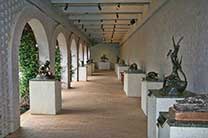
1. Can Can by Jane DeDecker (born 1961.) The Jane DeDecker's dancers represent a cancer victim with 4 friends helping her through the process of dying. An allegory of the human spirit's triumph over death. This clay sculpture received the 1999 National Sculpture Society's Silver Medal. 2. and 3. Brown Sculpture Court 4. Bella and the Bug by Louise Peterson (b. 1963) Bronze. Gift of sculptor. Originally trained in classical ballet, Louise Peterson did not begin to study sculpture until 1987. Bella and the Bug was inspired by observing her pet showing a disturbed level of concentration for many minutes while inspecting a fly. 5. Spout for a drinking fountain by Anna Hyatt Huntington (1876 - 1973) Aluminum, 1953. Anna Hyatt Huntington was te first sculptor in America to cast in aluminum which she liked for its light weight and luster. This duck sculpture was designed to accompany the oak-leaf carved marble base which was later re-purposed as a drinking fountain. Click each photo to enlarge
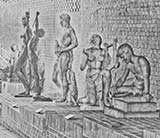
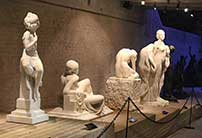





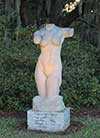
1. Indian and Eagle by Carl Paul Jennewein 1890 - 1978. Bronze. 1929. Among Jennewein's early commissions was this one for a World War 1 American monument llocated in Tours, France. The sculptor envisioned an eagle being released by a Native American as a symbol of freedom and the American love of liberty. Modeled in 1929, this small study for a final version received the Widener Memorial Medal of gold in Philidelphia. 2. Christ Child by Abram Belskie (1907 - 1988) Serravizza marble, 1934. S.1934.024 3. Sylvan by Chester Beach (1881 - 1956) White Marble S.1932.001 4. Torse de Femme by David Klass (b. 1941) Infiana limestone, c. 1989. Gift of the sculptor. David Klass studied art and architecture at Pratt Institute in Brooklyn.For two years he he studied anatomy at Columbia College of Physicians and Surgeons as an adjunct to his own sculpture development. His work is in the Metropolitan Museum of Art and many other collections. 5. Sonata by Mario Joseph Korbel (1882 - 1954) White Marble. S.1932.031 6. Siberian Ram by Marshall Maynard Fredericks (1908-1998) The anaimal sculpture of Marshall Fredericks is both energetic and whimsical, as seen in this depiction of a ram. Carved in limestone in 1063 for the grounds of the Baldwin public Library in Burmingha, Michigan, Siberian Ram lost none of its power when cast in bronze. Click each image tp enlarge

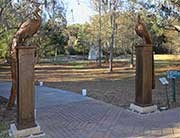
1. Peacocks by Dan Ostermiller (b. 1956) Bronze, 2004. On loan from thePrivate Collection of Tia. A fascination with wildlife led Dan Ostermiller at an early age to become a sculptor. Although his work is realistic, it's not just an accurate rendering, but a skillful blend of lines, composition and texture. As a self-taught artist, Ostermiller draws upon his knowledge of animal anatomy acquired through years of observation. His works are public and private collections worldwide. 2. A penchant for astrological and mythological symbolism comes across clearly in Paul Howard Manship's work. The sundial symbolizes the cycle of life encompassed by the cycle of eternity. It is patterned after an astronomical devise composed of rings, representing the great circles of the heavens. In the rings and base depicted the elements, seasons, hours of day and signs of the Zodiac. 3. Polar Bears by Frederick George Richard Roth (1872-1944) Frederick Roth preferred to present animals in natural settings using an impressionistic modeling stylw. His work often depicted his subtle sense of humor and preference for movement, Polar Bears assured his election to the National Academy of Design in 1906 and won the National Arts Club prize in 1924. 4. and 5. Neptune (4) and Amphitrite (5) by Wheeler Williams (1897 - 1972) Lead, 1939. Representing the youthful ggod of the sea, Neptune, and his wife Amphitrite, these two figures are part of "The Childhood of the Gods." Neptune stands with a trident in hand, while Amphitrite (who has the body of a mermaid) holds a seashell to her ear. Click each photo to enlarge

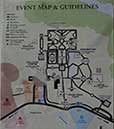
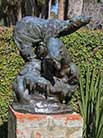
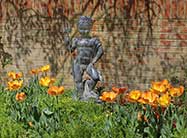


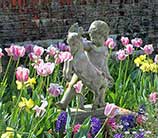



1. Fillies Playing by Anna Hyatt Huntington (1876 - 1973) Bronze, 1956. This example was accomplished in 2010. Anna Hyatt Huntington created two sizes of Fillies Playing in her studio at Stanerigg Farm near Redding, CT. The small version (1955) is thought to have never been cast; the large version (1956) apparently was cast only once. The aluminum casting, made by Roman Bronze Works in New York City. was shown at the National Academy of Design and awarded the Elizabeth N. Waltrous Gold Medal in 1958 and was donated to the University of SC in 1960. This is a cast of the large version made in 2010 by Roman Bronze Studio with new moulds from the original plaster model. 2. A Female Centaur by Anna Hyatt Huntington (1876-1973) Brass, 1936. Designed as a companion to Cheiron and exhibited at the 1939 New York World's Fair, this creature was given female attributes within a male form. The fierce stance and primitive features add a menacing quality to the depiction 3. The Centaur Cheiron by Anna Hyatt Huntington Cheiron, a wise centaur in Greek mythology, was an experr in medicine due to his knowledge of herbs. For his skill in healing arts he was rewarded with immortality. But after a painful wound in battle, he chose death over an eternity of suffering. Zeus placed him in the heavens where he because the constellation known as The Archer, Sagittarius. 4. The Hungry Loop by Herb Mignery (b. 1937) Rather than folloe his family's 110 year tradition of Nebraska ranching, Mignery had a degree in commercial art before turning to fine art. This sculpture depicts an African-American on horseback, parrot of the history of cowboys in the West. The tital is a term used to describe a rodeo roper who desperately needs to win this event. Mignery wrote "the subject is obviously well-worn from her efforts. However, I have portrayed his demeanor and posture to indicate that he will eventually succeed." 5. and 6. Boy and Girl Dolphins by Milton Horn (1906-1995) Limestone 1929. Milton Horn came to the United States from Russis in 1913. He settled in Taunton, MA and studies art with Hudson Kitson in Boston, and later at Beux-Art Institute of Design in New York. From 1939 to 1949, he collaborated with Frank Lloyd Wright. Click each photo to enlarge
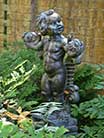
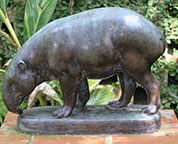

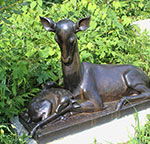
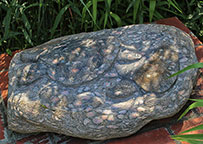

1. Boy and Snails by Joseph Emile Renier (1887-1966) Bronze. A multi-talented artist, Joseph Renier was equally skilled in creating monumental, architectural and relief sculpture, His award winning garden figures reflect both gaiety and originality of design. The sketch for this figure earned a Garden of America prize in 1928 2. Gentle Tapir. Dorothea Schwarez Greenbaum (1893 - 1986) In 1927, after several decades of formal study in painting, Dorothea Schwarez Greenbaum began to mode lanimals in culpture. Her versatility in media-terra cotta, bronze, and hammered lead - resulted in Greenbaum's popularity among museums. This pice was modeled in 1943 in the Washington Zoo. The friendly, place temperament of the animal is evident. 3. Dancing Goat by Albert Laessle (1877 - 1954) Bronze 1928. A goat prances on his hind legs, forefeet waving in the air and neck arched. It is standing on a clump of rushes containing a snail, turtle and other marsh crushes. The goat's hair rises in a ridge with a braid at each side. A collar encircles its neck and horns are coveredwith knobs. 4. Doe by Marion Branning (dates unknown) Bronze. Designed in broad planes, this gentle sculpture evoks visions of a quiet landscape scene. . The artist, who graduated from the Rinehart School of Sculpture at Baltimore in 1929, also taught techniques of jewelry and metal work at the the Maryland Institute. 5. Warm Currents Steve Kestrel (b. 1951) River Stone, 2000. Acquired with fundsn from the Sculpture Acquisition Fund. Sea turtles are air-breathijng reptiles remarkably adapt to living in the sea. A streamlined shape, large and powerful fore flippers enable them to dive to great depths and travel lobg distances. Although home in the ocean, sea turtles are tied to the land because females must leave the water to lay their eggs on a sandy beach. 6. Great Blue Heron by Catherine K. Ferrell (b. 1947) Bronze, 1999. Acquired with funds from the Sculpture Fund and friends of the sculptor. The largest of the herons on this continent, the Great Blue Heron typically lives near ponds, marshes, streams and tidal flats. Herons nest in communities with their own, along with other birds. Click each photo to enlarge
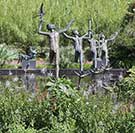
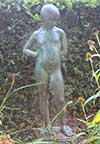
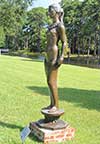

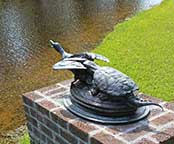
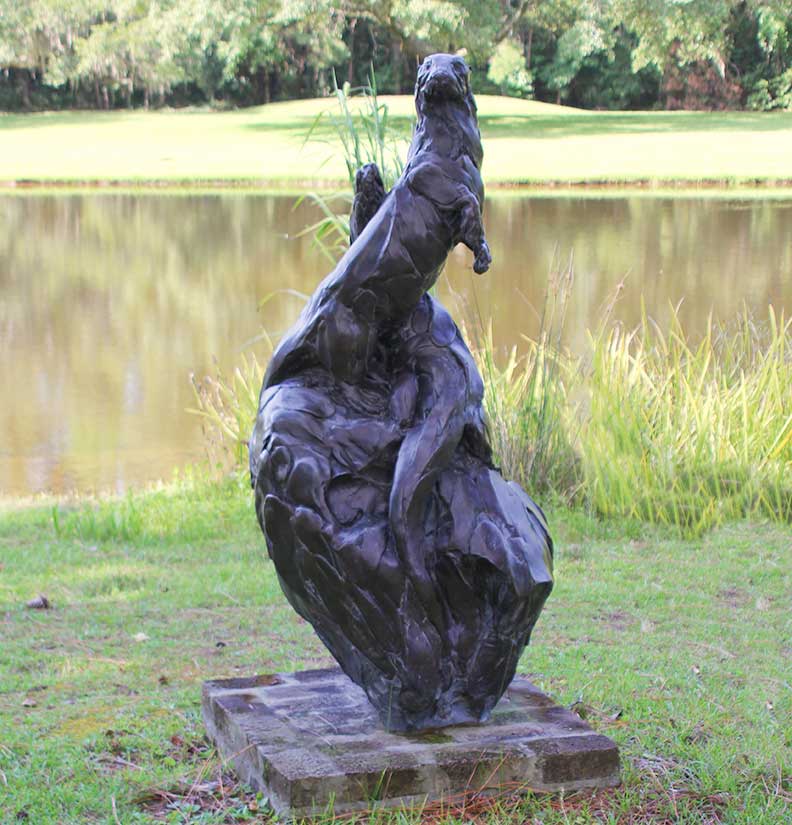
1. My Niece, 1883-1952. By Jo Davidson distinguished himself as a portraitist, working rapidly so that he could express his thoughts as they came. His ability to present innnate qualities with startling clarity was coupled with his flair for capturing the physical appearance of the sitter. 2. April, by Charles Cropper Parks (1922 - 2012) Bronze 1998. Gift of sculptor. Modeled in the late 80s, this figure was based on the design of an earlier small sculpture of the Roman Goddess of Flowers, Flora. This work was an experiment, cast in a commercial foundry from several small robber molds. Each part was then welded together to create a seamless casting in bronze. The lifetime works of Charles Cropper Parks is a Delaware treasure. 3. The Space Walker by Richard McDermott Miller (1922 - 2004) Bronze 1978. Gift of the sculptor. Often referred to as the "Figure Sculpture of Soho," Miller focused his work on the human figure, and, in particular, the females form. His figures always featured interesting composition and dynamic movement. Another casting og this size is located on the campus of Kent State University. 4. Duck and Turtle by Albert Laessle (1877 - 1954) Philadelphia native Albert Laessle's choice of animals as subjects began in his student days. He studies with Thomas Anshutz and Charles Grafly at the Pennsylvania An art critic wrote that he presented his students with something of the flavor of a humorous naturalist who observes the tragedies and comedies enacted in his little kingdom. 5. Black African Rhinoceros by Robert Henry Rockwell (1885 - 1973) Bronze, 1937. Rockwell's earlier years were spent at the National Museum in Washington D.C., the Brooklyn Institute of Arts and Sciences and the Cleveland Museum. Later, in the Museum of Natural History, Rockwell helped create the Akeley African Hall, where the life-size version of this rhinoceros was mounted. This study was modeled as a sketch for a habitat group placed in scenery of the northwest slope of Mt. Kenya. 6. Bernard Baruch Maira J. Kirby-Smith (b. 1949) Bronze, 2013 Gift of the Trustees of Brookgreen Gardens Bernard M. Baruch (1870 - 1965), the “Park Bench Statesman” made his fortune on Wall Street, but his satisfaction Another casting was his service to his country as an economic advisor during World Wars I and II and as a confidante to 6 American Presidents. The sculpture is located in Camden, SC where Baruch was born, is party of a larger work entitled ‘Reconciliation’. Maria Kirby-Smith has breated several monuments of his, such was Gen. Thomas Sumter, Judge Matthes W. Perry, and Strom Thurman. Click any photo to enlarge

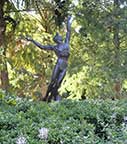
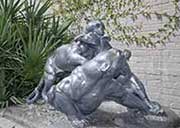
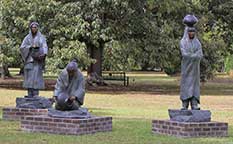

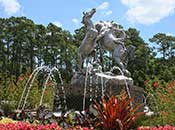
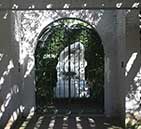
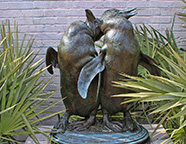
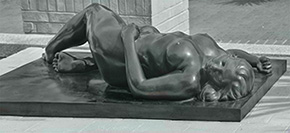
1. Tidal Rhythm by Christopher Smith (b. 1958) 2. The Bather by Gwen Marcus (b. 1956) Bronze, 2005. Gift of John and Cookie Cloyd and others. As a child, Gwen Marcus studied with Clementine Spampinato and Bruno Lucchesi. She went on to attend the National Academy School of Fine Arts Rhode Island School of Design, and the Art Students League. Marcus depicts diverse views of women. The Bather is also in the collection of the Chi Mei Museum, Taiwan, and Champs Hill, West Sussex, England, as well as private collections in England and New York. 3. High Tide by Charles Cropper Parks (1922 - 2012) Bronze 1985.Gift of the family. Known for his enchanting portraits of children, Parks embraced genre sculpture by placing his suvjects in casual setting and activities, The prototype for this sculpture, titled Boy and Gulls, was first conceived in 1976 for Mystic Seaport Museum in CT. The concept was remodeled in 1965 and enlarged to life size. 4. The Water Bearers by Glenna Goodacre (b. 1939) Bronze, 1985-1986. On long-term loan from the "Collection of Tia." Glenna Goodacre often presenters scenes from Native Anerican culture life in her sculpture. In 2002, Goodacre won the James Earle Fraser Sculpture awatd at the Prix de West Exhibition. In 2003, she was awarded the Gold Medal for Career Achievement from the Portrait Society of America was inducted into the Cowgirl Hall ofFame. Among her most significant commissions are the Vietnam Womens' Memorial in Washington, D.C. and the Irish Memorial in Philadelphia
Click amy photo to enlarge
Page 2. Flowers, Plants, Palm Trees
Page 3. Lowcountry Zoo, Birds, and more.







